Dominikanische Republik |
|
|
|
| Übersicht – Contents: | |
Diese Seite ist Teil des Projektes
Dominikanische Republik |
|
|
|
| Übersicht – Contents: | |
Flaggen – Flags: |
|
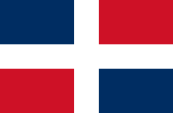 |
National- und Handelsflagge – national and merchant flag, Seitenverhältnis – ratio = 15:23, Quelle/Source nach/by: Flaggen und Wappen, Corel Draw 4 |
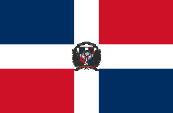 |
Staats- und Marineflagge – state and naval flag, Seitenverhältnis – ratio = 15:23, Quelle/Source nach/by: Flaggen und Wappen, Corel Draw 4 |
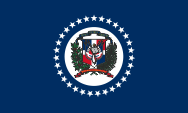 |
Gösch – naval jack, Seitenverhältnis – ratio = 3:5, Quelle/Source nach/by: Wikipedia (DE) |
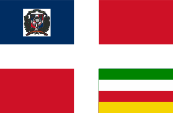 |
seit/since ca. 2000, Flagge der Armee – flag of the Army, Seitenverhältnis – ratio = 15:23, Quelle/Source nach/by: Ejército Nacional |
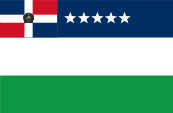 |
Flagge der Polizei – flag of the Police, Seitenverhältnis – ratio = 15:23, Quelle/Source nach/by: Flags of the World |
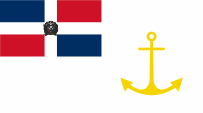 |
Flagge des Präsidenten – flag of the President, Seitenverhältnis – ratio = 5:9, Quelle/Source nach/by: Flaggen und Wappen |
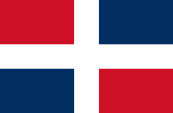 |
National- und Handelsflagge im Kriegsfall – national and merchant flag in war times, Seitenverhältnis – ratio = 15:23 |
historische Flaggen – historical Flags: |
|
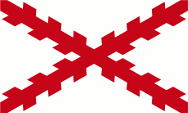 |
16./17. Jhd./cent., bis/to 1801 zum spanischen Machtbereich – to the Spanish sphere of influence, Quelle/Source nach/by: Wikipedia (EN) |
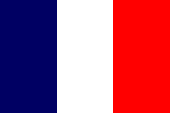 |
1801–1805, Flagge Frankreichs – flag of France, Seitenverhältnis – ratio = 2:3, Quelle/Source: Corel Draw 4 |
 |
1805–1808, Flagge von Haiti – flag of Haiti, Quelle/Source nach/by: Die Welt der Flaggen |
 |
1808–1821 zum spanischen Machtbereich – to the Spanish sphere of influence, Quelle/Source nach/by: Wikipedia (EN) |
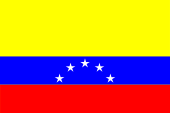 |
1821–1822, Nationalflagge – national flag, Quelle/Source nach/by: World Statesmen |
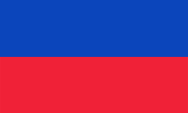 |
1822–1844, Flagge von Haiti – flag of Haiti, Quelle/Source nach/by: Die Welt der Flaggen |
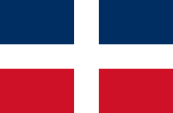 |
Februar 1844 bis/to November 1844, Nationalflagge – national flag, Quelle/Source nach/by: Flags of the World |
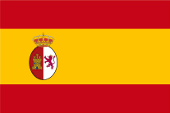 |
1861–1863, Flagge Spaniens – flag of Spain, Quelle/Source nach/by: Die Welt der Flaggen |
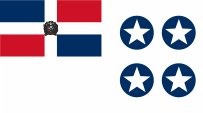 |
1930–1961, Flagge des Generalissimus – flag of the Generalissimo, Seitenverhältnis – ratio = 5:9, Quelle/Source nach/by: Flaggenbuch 1939 |
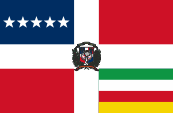 |
bis/to ca. 2000, Flagge der Armee – flag of the Army, Seitenverhältnis – ratio = 15:23, Quelle/Source nach/by: Flags of the World |
Bedeutung/Ursprung der Flagge – Meaning/Origin of the Flag: |
|
| Als die Dominikanische Republik im Jahre 1821 das erste Mal unabhängig wurde, war eine nach dem Vorbild Großkolumbiens gelb-blau-rot gestreifte Flagge, bzw. die Flagge Großkolumbiens in Gebrauch, denn es wurde ein Anschluss an diesen Staat angestrebt. Sie verschwand mit der Haitianischen Annexion im Jahre 1822. Im antihaitianischen Befreiungskampf schuf der Führer der Geheimgesellschaft der Trintarier, Juan Pablo Duarte, eine Flagge, die ein weißes Kreuz auf die erste, blau-rote Flagge von Haiti auflegte. Nach dem Sieg über Haiti im Jahre 1844 wurde diese Flagge wurde zur Proklamation der Unabhängigkeit am 27.02.1844 als Flagge der Dominikanischen Republik gehisst. Aus ästhetischen Gründen wurde die Flagge am 06.11.1844 (nach anderen Quellen am 08.11.1844) in die heutige Form abgeändert. Das Blau steht für die Freiheit, das Rot für das im Freiheitskampf vergossene Blut, das weiße Kreuz repräsentiert den religiösen Glauben des Volkes. Als Farben für die Flaggen werden heute angegeben: Rot = pt 295, Blau = pt 186, Grün = pt 355, Gelb = pt 109. | As the
Dominican Republic get independent for the first time in the year 1821, was
in use, a yellow-blue-red striped flag flag after the example of Great
Colombia, or the flag of Great Colombia itself, because it was aimed a
annexation to that state. It disappears with the Haitian annexation in the
year 1822. In the anti-haitian liberation fight created the leader of the
secret society of the Trintarians, Juan Pablo Duarte, a flag which set a
white cross on the initially blue-red flag of Haiti. After the victory over
Haiti in the year 1844 this flag became to the flag of the Dominican
Republic at the proclamation of the independence on 27th of February in
1844. Because of aesthetical reasons the flag was changed on 6th of November
in 1844 (by other sources on 8th of November in 1844) into the today's form.
The blue stands for the freedom, the red for the in the fight for freedom
sheded blood, the white cross represents the religious believe of the
nation. The colors given for the flags today are: red = pt 295, blue = pt 186, green = pt 355, yellow pt 109. |
| Quelle/Source: Die Welt der Flaggen, Wappen und Flaggen aller Nationen, Flaggen Wappen Hymnen, Wikipedia (EN) | |
Wappen – Coat of Arms: |
|
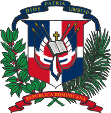 |
Wappen der Dominkanischen Republik – coat of arms of the Dominican Republic, Quelle/Source nach/by: Flaggen und Wappen, Corel Draw 4 |
Bedeutung/Ursprung des Wappens – Meaning/Origin of the Coat of Arms: |
|
| Das im Jahr 1844 eingeführte (und bis dato nur in wenigen Details abgeänderte) Wappen der Dominikanischen Republik zeigt ein Wappenschild nach dem Vorbild der Flagge. Mittig darauf vier gekreuzte dominikanische Flaggen, zwei gekreuzte Lanzen, eine aufgeschlagene Bibel und ein goldenes Kreuz. Das Wappen ist umgeben von einem Kranz aus je einem Palmen- und einem Lorbeerzweig. Oberhalb ein blaues Spruchband mit dem Staatsmotto in goldenen Lettern: "Dios, Patria, Libertad" → "Gott, Vaterland, Freiheit". Unterhalb ein rotes Schriftband mit dem Namen des Staates, ebenfalls in goldenen Lettern. | The in
1844 introduced (and until today only in some details changed) coat of arms
of the Dominican Republic shows a blazon after the example of the flag.
Median thereupon four crossed Dominican flags, two crossed lances, a opened
bible and a golden cross. The scutcheon is surrounded by a garland from ever one palm twig and one laurel twig. Above a blue saying ribbon with the motto of the state in golden letters: "Dios, Patria, Libertad" → "God, Fatherland, Freedom". Below a red banner with the name of the state, likewise in golden letters. |
| Quelle/Source: Die Welt der Flaggen, Wappen und Flaggen aller Nationen, Flaggen Wappen Hymnen | |
Flugzeugkokarde – aircraft roundel: |
|
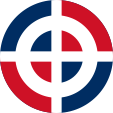 |
Flugzeugkokarde – aircraft roundel Quelle/Source: nach/by Wikipedia (EN) |
Landkarten – Maps: |
Lage – Position: |
Landkarte des Landes – Map of the Country: |
|
|
Zahlen und Fakten – Numbers and Facts: |
|
|
|
|
|
|
|
|
|
|
|
|
|
|
|
|
|
|
|
Geschichte: |
|
05.12.1492
· der spanische Seefahrer Christof Kolumbus entdeckt die Insel auf der heute
Haiti und die Dominikanische Republik liegen, und nennt sie "La Isla
Española", und nimmt sie für Spanien in Besitz 1494 · Beginn der spanischen Kolonisierung 1496 · Gründung von Santo Domingo (heute Hauptstadt der Dominikanischen Republik), der Name der Stadt wurde später für die ganze Insel übernommen 1500 · Kronkolonie "Santo Domingo" unter einem vom Spanischen König eingesetzten Gouverneur 1505 · Import der ersten schwarzen Sklaven als Ersatz für die aussterbende indianische Urbevölkerung 17. Jhd. · Piraten (Bukanier und Flibustier) lassen sich an der Küste der Insel nieder, besonders auf der vorgelagerten Insel Tortuga (Île de la Tortue), die Piraten im Westteil der Insel stehen dabei unter französischem Schutz 1697 · Friede von Rijswijk, Spanien muss den Westteil der Insel (Saint Domingue) an Frankreich abtreten, damit Teilung der Insel 1794 · Aufhebung der Sklaverei 1801 · Toussaint l'Ouverture wird Präsident von Haiti (ehemals Saint Domingue), Eroberung des spanischen Ostteils der Insel (Santo Domingo) durch die Aufständischen 1803 · antifranzösische Aufstände, die Aufständischen schlagen die französischen Interventen 01.01.1804 · Dessalines erklärt Haiti endgültig für von Frankreich unabhängig und lässt sich als Kaiser Jacob I. von Haiti ausrufen, erneute Intervention durch Frankreich (im Osten der Insel) 1805 · Haiti erobert erneut Santo Domingo (den Osten der Insel), die heutige Dominikanische Republik 1806 · Kaiser Jakob I. wird ermordet, Schwarze und Mulatten wenden sich gegeneinander, Bürgerkrieg, Anarchie 1808 · Santo Domingo, die heutige Dominikanische Republik, kommt wieder unter spanische Herrschaft 1821 · der spanische Teil der Insel (Santo Domingo) erklärt seine Unabhängigkeit von Spanien (Unabhängiger Staat Spanisch-Haiti) 1822 · Santo Domingo schließt sich dem Staat Haiti an 1843 · Sturz von J. P. Boyer durch aufständische Schwarze 1844 · Aufstand der Mulatten im ursprünglich spanischen Teil der Insel, dieser trennt sich als selbständige Republik Santo Domingo wieder von Haiti ab (=> Dominikanische Republik) 27.02.1844 · Unabhängigkeit der Dominikanischen Republik von Haiti 18.03.1861 · die Dominikanische Republik befürchtet die Eroberung durch Haiti und unterstellt sich daher dem Schutz Spaniens und wird wieder spanische Kolonie 14.09.1863 · die Dominikanische Republik erklärt sich für souverän 11.07.1865 · Spanien erkennt die Unabhängigkeit des Landes an 1869–1870 · US-amerikanische Intervention 1903–1905 · US-amerikanische Intervention 1905–1941 · die Dominikanische Republik ist US-amerikanisches Protektorat 1916–1924 · von Truppen der USA besetzt 1930 · Trujillo-Putsch 1961 · Ermordung von Trujillo 1963 · Wahlen, Bosch wird demokratisch gewählter Präsident 1963 · Militärputsch 1964 · Volksaufstand 1965-1966 · US-amerikanische und OAS-Intervention 1966 · Balaguer zum Präsidenten ernannt 1996 · Reyna wird demokratisch gewählter Präsident ab 2000 · wechselnde Präsidentschaften nach demokratischen Wahlen |
History: |
|
5th of December 1492 · the Spanish seafarer Christoph Columbus
discovers that island on which Haiti and the Dominican Republic are today
situated, and names it "La Isla Española", and appropriates it for
Spain 1494 · start of the Spanish colonization 1496 · foundation of Santo Domingo (today capital of the Dominican Republic), the name of that town gets later taken over for the whole island 1500 · crown colony "Santo Domingo" under a by the Spanish King installed gouverneur 1505 · import of the first black slaves as substitute for the vanishing native Indians 17th cent. · pirates (Buccaneer and Flibusteer) settle down on the coast of the island, especially on the near Tortuga Island (Île de la Tortue), the pirates in the western part of the island stand thereby under French protection 1697 · Peace of Rijswijk, Spain has to cede the western part of the island (Saint Domingue) to France, therewith partition of the island 1794 · abolition of the slavery 1801 · Toussaint l'Ouverture becomes president of Haiti (former Saint Domingue), capture of the Spanish eastern part of the island (Santo Domingo) by the insurgents 1803 · Anti-French riotings, the insurgents strike the French invasors 1st of January in 1804 · Dessalines declares Haiti irrevocably for independent from France and lets proclaim itself as emperor Jacob I. of Haiti, once more intervention by France (in the east of the island) 1805 · Haiti conquers again Santo Domingo (the east of the island), the today's Dominican Republic 1806 · emperor Jakob I. gets assassinated, Blacks and Mulattos turn against each other, civil war, anarchy 1808 · Santo Domingo, the today's Dominican Republic, comes under Spanish rule again 1821 · the Spanish part of the island (Santo Domingo) declares its independence from Spain (Independent State of Spanish Haiti) 1822 · Santo Domingo joins the state Haiti 1843 · overthrow of J. P. Boyer by insurgent Blacks 1844 · revolt of the Mulattos in the initially Spanish part of the island, those separates as independent Republic of Santo Domingo from Haiti (=> Dominican Republic) 27th of February 1844 · independence of the Dominican Republic from Haiti 18th of March 1861 · the Dominican Republic is concerned about a possible occupation by Haiti and is subjects therefore to the protection of Spain and becomes again a Spanish colony colony 14th of September 1863 · the Dominican Republic declares itself as sovereign 11th of July 1865 · Spain recognizes the independence of the country 1869–1870 · US-American intervention 1903–1905 · US-American intervention 1905–1941 · the Dominican Republic is a US-American protectorate 1916–1924 · occupied by troops of USA 1930 · Trujillo coup 1961 · assassinantion of Trujillo 1963 · Bosch became democratical elected president 1963 · military revolt 1964 · mass rebellion 1965 · US-American and OAS intervention 1966 · Balaguer nominated for president 1996 · Reyna became democratical elected president from 2000 · rotating presidencies after democratic elections |
| Quelle/Source: Weltgeschichte, World Statesmen, Wikipedia (D) |
Ursprung des Landesnamens – Origin of the Country's Name: |
|
| Der Name des Landes geht auf den Namen der Hauptstadt "Santo Domingo" zurück, was "Heiliger Sonntag" heißt. Als Kolumbus am 5. Dezember 1492 die Insel entdeckte, auf der heute die Staaten Haiti und Dominikanische Republik liegen, nannte er sie "La Isla Española" (die Spanische Insel), im Laufe der Zeit wurde "Hispaniola" daraus. Der Name hat sich bis heute erhalten, auch wenn Einheimische heute ab und zu das Wort "Kiskeya" verwenden. Ein weiterer Name für die Insel war "Santo Domingo", nach der 1496 gegründeten Stadt. Im französischen Inselteil wurde daraus "Saint Domingue". | The name
of the country has its roots in the name of the capital"Santo Domingo",
which means "Holy Sunday". When Columbus on the 5th of December 1492 discovered the island – on which today are placed the states Haiti and Dominican Republic – he named it "La Isla Española" (the Spanish Island), in the course of time it became "Hispaniola". The name is in use until today, although locals sometimes use the word "Kiskeya". Another name for the island was "Santo Domingo", by the in 1496 founded city. In the French part of the island it became "Saint Domingue". |
| Quelle/Source: Atlas der wahren Namen, Wikipedia (D) | |